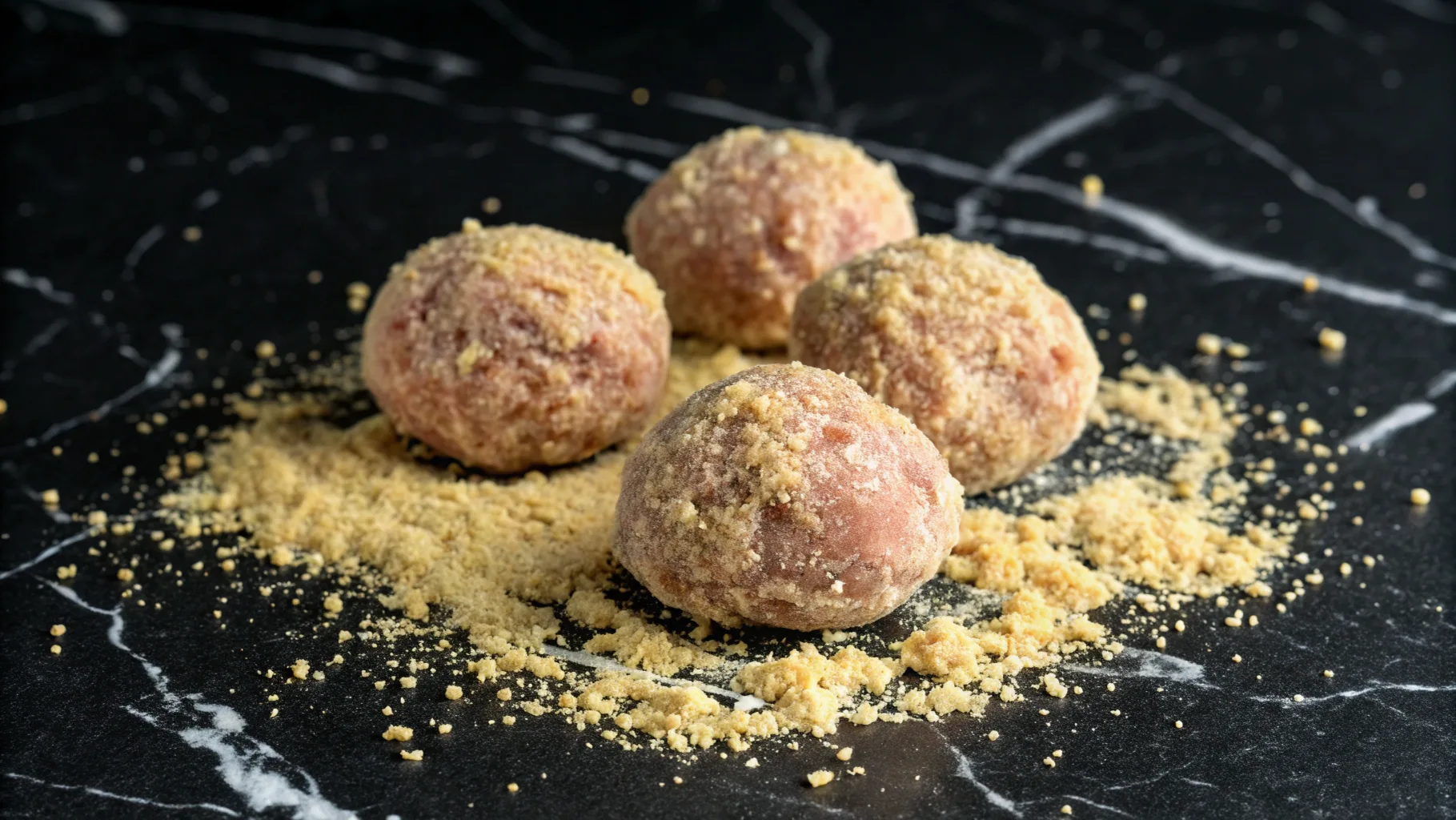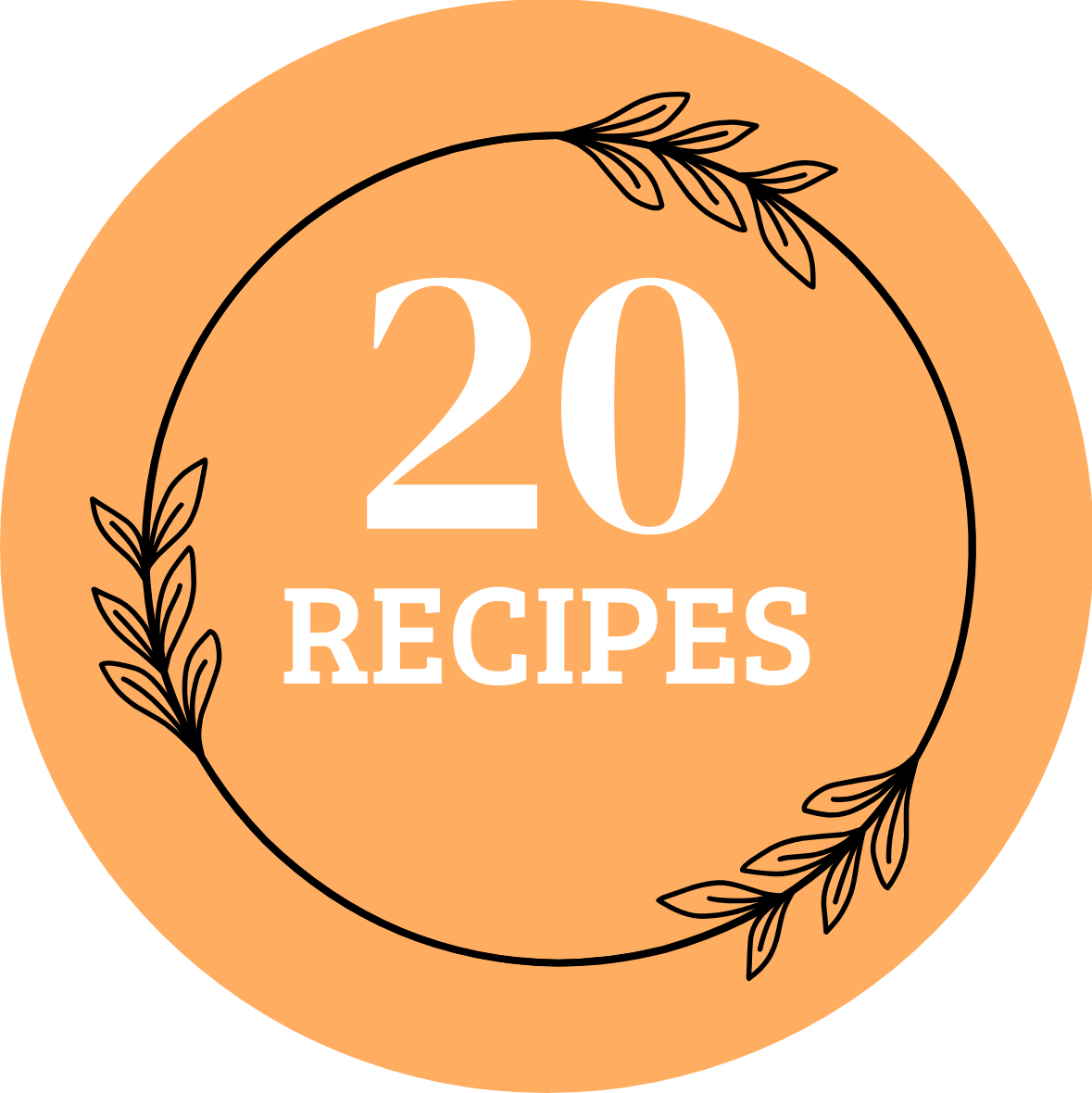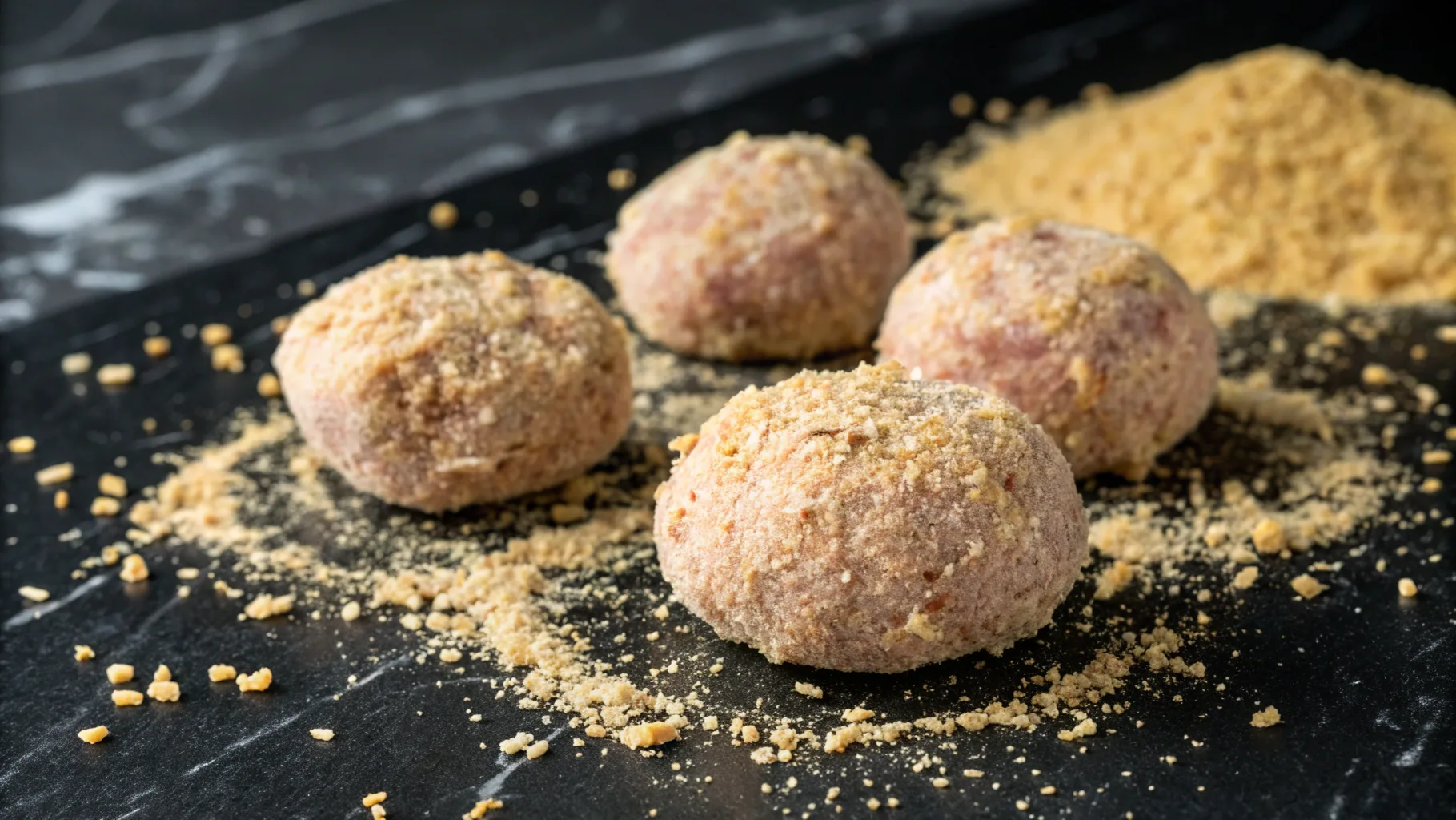Gluten-free meatball binder
Finding the perfect Gluten-free meatball binder can be challenging, but with the right alternatives, you can enjoy flavorful, tender meatballs without gluten. Whether you’re following a gluten-free diet due to celiac disease, gluten sensitivity, or simply looking for healthier options, this guide covers the best substitutes and how to use them effectively.
Why Are Breadcrumbs Important in Meatballs?

Breadcrumbs play a crucial role in creating the perfect meatball, impacting both the structure and the overall eating experience. Their importance goes beyond just being a filler—they significantly enhance the texture, moisture, and flavor of meatballs. Here’s a deeper look into why breadcrumbs are essential:
1. Binding Agent
Breadcrumbs act as a key binding agent in meatballs. When mixed with eggs and ground meat, they help hold all the ingredients together, preventing the meatballs from falling apart during cooking. Without a proper binder, the meat mixture can crumble or become too dense. Breadcrumbs absorb moisture from other ingredients, creating a cohesive mixture that’s easy to shape and cook evenly.
2. Moisture Retention
One of the most important functions of breadcrumbs is their ability to lock in moisture. During cooking, ground meat can release juices and dry out, resulting in tough and chewy meatballs. Breadcrumbs absorb and hold onto the liquid ingredients, like milk or broth, slowly releasing moisture as the meatballs cook. This process ensures the meatballs stay juicy, tender, and flavorful.
3. Improved Texture
Breadcrumbs contribute to the light, fluffy texture that makes meatballs enjoyable to eat. Without them, meatballs can turn out dense and heavy. The crumbs create tiny air pockets in the mixture, making the meatballs softer and more tender. This balance of firmness and fluffiness is what gives traditional meatballs their satisfying bite.
4. Flavor Enhancement
Breadcrumbs also help distribute seasoning evenly throughout the mixture. They absorb spices, herbs, and other flavorings, ensuring that each bite is consistently seasoned. Some recipes use seasoned breadcrumbs to add an extra layer of flavor to the meatballs.
If you’re looking for a gluten-free alternative, breadcrumbs can be replaced with gluten-free options like almond flour, oats, or crushed gluten-free crackers. These substitutes offer similar benefits—binding, moisture retention, and texture—without compromising on taste.
Interested in more gluten-free cooking ideas?
Check out this Gluten-Free Meatballs Recipe for a healthy and delicious alternative that’s perfect for any occasion!
Top Gluten-free meatball binder
1. Rolled Oats
Rolled oats are naturally gluten-free and offer excellent binding and texture.
- Use a 3:4 ratio compared to breadcrumbs.
- Ensure oats are labeled gluten-free to avoid cross-contamination.
2. Almond Flour or Almond Meal
Almond flour provides a nutty flavor and rich texture.
- Works best in baked meatballs.
- High in protein and healthy fats.
3. Crushed Rice or Corn Chex Cereal
These cereals are naturally gluten-free and mimic the light texture of breadcrumbs.
- Finely crush for better binding.
- Ideal for crispier meatballs.
4. Mashed Potato Flakes
These are excellent for keeping meatballs moist and tender.
- Absorb moisture well, preventing dryness.
- Great for soft, delicate meatballs.
5. Gluten-Free Crackers or Pretzels
Crushed gluten-free crackers or pretzels provide a similar texture to traditional breadcrumbs.
- Adjust salt levels due to seasoning in crackers.
- Pulse in a food processor for a fine crumb.
For more ideas on incorporating gluten-free ingredients, check out this Protein Baked Oatmeal for a healthy breakfast option.
How to Substitute Gluten-Free Ingredients in Meatballs

Switching to gluten-free binders requires a few simple adjustments:
- Adjust Liquid Ratios: Some substitutes absorb more moisture than breadcrumbs.
- Use Extra Binders: Adding an extra egg can improve the mixture’s cohesion.
- Flavor Balance: Be mindful of seasoning, especially when using salty substitutes.
Gluten-Free Meatball Binder Recipe Ideas
Choosing the right gluten-free meatball binder is essential for creating flavorful, juicy, and perfectly textured meatballs. Whether you’re avoiding gluten for health reasons or simply looking for a lighter option, these creative recipes use alternative binders that work just as well as traditional breadcrumbs. Below are some delicious and easy gluten-free chicken meatball recipes that highlight the best binders for a perfect bite.
1. Classic Italian Chicken Meatballs with Rolled Oats (Gluten-Free Meatball Binder)
Ingredients:
- 1 lb ground chicken
- ½ cup gluten-free rolled oats (excellent gluten-free meatball binder)
- 1 egg
- 2 garlic cloves, minced
- 1 tsp dried oregano
- Salt and pepper to taste
Instructions:
- In a large bowl, combine ground chicken, rolled oats, egg, garlic, oregano, salt, and pepper.
- Mix until all ingredients are well combined.
- Form the mixture into evenly sized meatballs.
- Place the meatballs on a baking sheet lined with parchment paper.
- Bake at 375°F (190°C) for 20-25 minutes or until fully cooked and golden brown.
Why It Works:
Gluten-free rolled oats act as a perfect gluten-free meatball binder, absorbing moisture and holding the mixture together without making the meatballs dense.
2. Chicken Meatballs with Almond Flour (Low-Carb Gluten-Free Meatball Binder)
Ingredients:
- 1 lb ground chicken
- ½ cup almond flour (great gluten-free meatball binder)
- 1 egg
- 1 tbsp fresh parsley, chopped
- 1 tsp garlic powder
- Salt and pepper to taste
Instructions:
- Mix ground chicken, almond flour, egg, parsley, garlic powder, salt, and pepper in a bowl.
- Shape the mixture into small meatballs.
- Bake at 375°F (190°C) for 20 minutes or pan-fry in olive oil for a crispy texture.
Why It Works:
Almond flour adds a subtle nutty flavor and acts as a moist, low-carb gluten-free meatball binder, ensuring the meatballs stay tender and juicy.
3. Chicken Zucchini Meatballs with Coconut Flour (Moist Gluten-Free Meatball Binder)
Ingredients:
- 1 lb ground chicken
- ¼ cup coconut flour (absorbent gluten-free meatball binder)
- 1 small zucchini, grated and drained
- 1 egg
- 1 tsp onion powder
- Salt and pepper to taste
Instructions:
- Combine ground chicken, coconut flour, zucchini, egg, onion powder, salt, and pepper.
- Form into meatballs and arrange on a greased baking tray.
- Bake at 375°F (190°C) for 25 minutes, flipping halfway for even cooking.
Why It Works:
Coconut flour is a highly absorbent gluten-free meatball binder that pairs well with moist ingredients like zucchini, creating juicy meatballs with a hint of sweetness.
4. Spicy Chicken Meatballs with Chia Seeds (High-Fiber Gluten-Free Meatball Binder)
Ingredients:
- 1 lb ground chicken
- 2 tbsp chia seeds (unique gluten-free meatball binder)
- 1 egg
- 1 tsp chili flakes
- 2 garlic cloves, minced
- Salt and pepper to taste
Instructions:
- In a bowl, mix chia seeds with ¼ cup water and let sit for 10 minutes to form a gel.
- Combine the chia mixture with ground chicken, egg, chili flakes, garlic, salt, and pepper.
- Roll into meatballs and bake at 375°F (190°C) for 20-25 minutes.
Why It Works:
Chia seeds create a gel-like consistency when soaked, making them an excellent high-fiber gluten-free meatball binder that adds moisture and nutrition.
Choosing the Best Gluten-Free Meatball Binder
Each of these recipes showcases how versatile gluten-free meatball binders can be. Whether you prefer oats, almond flour, coconut flour, or chia seeds, these ingredients offer binding strength and enhance flavor and texture. Experiment with these options to find your favorite combination for soft, flavorful, and gluten-free chicken meatballs.
Looking for crispy sides to complement your meatballs?
Explore this guide on What Keeps Chicken Crispy for expert frying tips and delicious pairing ideas!
Common Mistakes to Avoid When Using Gluten-Free Meatball Binders
Successfully making Gluten-free meatball binder requires more than just swapping out traditional breadcrumbs. Understanding how different gluten-free binders work and how to adjust recipes accordingly is key to achieving meatballs that are moist, flavorful, and perfectly held together. Here are some common mistakes to avoid and tips for ensuring the best results.
1. Skipping Moisture Adjustments
Mistake: Many gluten-free binders, like almond flour or coconut flour, absorb significantly more liquid than traditional breadcrumbs. If the moisture content isn’t properly adjusted, this can result in dry and crumbly meatballs.
Solution:
- Increase liquid ingredients such as eggs, milk, or broth to balance the mixture.
- Add moisture-rich ingredients like grated zucchini or chopped onions for softness.
- Start with smaller amounts of dry binders and gradually add more as needed.
For more insights on how to adjust moisture levels in gluten-free baking and cooking, check out this helpful guide from America’s Test Kitchen.
2. Over-Seasoning
Mistake: Certain gluten-free substitutes like gluten-free crackers, pretzels, or even pork rinds can be pre-seasoned or saltier than traditional breadcrumbs. Adding the usual amount of salt and spices without adjusting for these ingredients can lead to overly salty meatballs.
Solution:
- Taste the binder first and reduce the salt in your recipe if using salty substitutes.
- Opt for unsalted or lightly salted gluten-free products when available.
- Balance flavors with fresh herbs, garlic, and spices instead of relying solely on salt.
3. Insufficient Binding
Mistake: Some gluten-free binders don’t provide enough structure to hold the meatballs together, causing them to fall apart during cooking. This is especially true with light binders like rolled oats or rice flour.
Solution:
- Add an extra egg or two to improve the binding.
- Use sticky binders like chia seeds or flaxseed meal mixed with water to create a gel-like consistency.
- Let the mixture rest for 10–15 minutes before forming meatballs to allow the binder to absorb moisture and firm up.
4. Using Too Much Binder
Mistake: Overcompensating by adding too much gluten-free binder can result in dense and heavy meatballs rather than light and tender ones.
Solution:
- Start with a small amount of binder and gradually increase as needed.
- Maintain a good balance between meat, binder, and liquid for the desired texture.
- Stick to a general ratio of about ¼ to ½ cup of binder per pound of meat.
5. Not Mixing Ingredients Evenly
Mistake: Unevenly mixing the ingredients can create dry or overly moist sections within the meatballs, leading to inconsistent texture and flavor.
Solution:
- Mix the meatball mixture gently and evenly by hand to avoid overworking the meat.
- Distribute the binder and seasonings throughout the mixture to ensure even binding and flavor.
- Avoid compacting the meat mixture too tightly, which can make meatballs tough.
6. Skipping the Chilling Step
Mistake: Forming and cooking meatballs immediately after mixing can cause them to fall apart during cooking, especially with softer gluten-free binders.
Solution:
- Chill the mixture in the refrigerator for 20–30 minutes before shaping the meatballs.
- This step allows the binder to absorb moisture fully and firms up the mixture for easier handling.
By avoiding these common mistakes and making small adjustments, you can create perfectly bound, moist, and flavorful Gluten-free meatball binder. Understanding how different binders interact with the meat mixture ensures your meatballs hold together beautifully and deliver the taste and texture you crave.
FAQs About Gluten-free meatball binder

Q: What is the best gluten-free substitute for breadcrumbs in meatballs?
A: The best gluten-free substitutes for breadcrumbs in meatballs are rolled oats, almond flour, and mashed potato flakes.
- Rolled oats offer a mild flavor and soft texture, making them perfect for binding without overpowering the taste.
- Almond flour adds a nutty flavor and works well for low-carb or keto-friendly meatballs.
- Mashed potato flakes provide excellent moisture retention and result in soft, tender meatballs.
Additionally, you can try gluten-free crackers, rice flour, or quinoa for unique textures and flavors.
Q: Can I make gluten-free meatballs without eggs?
A: Absolutely! If you’re avoiding eggs, there are several excellent egg-free binders you can use:
- Flaxseed Meal: Mix 1 tablespoon of flaxseed meal with 3 tablespoons of water and let it sit for a few minutes to thicken.
- Chia Seeds: Combine 1 tablespoon of chia seeds with 3 tablespoons of water as a binding gel.
- Mashed Potatoes or Sweet Potatoes: These naturally starchy ingredients help hold the meat mixture together.
- Unsweetened Applesauce: Adds moisture and binding while keeping the meatballs tender.
These alternatives not only replace eggs but also add nutritional value to your meatballs.
Q: Do gluten-free substitutes change the flavor of meatballs?
A: Some gluten-free binders can subtly alter the flavor, but proper seasoning ensures your meatballs remain delicious.
- Almond flour adds a light, nutty flavor that pairs well with savory herbs.
- Pork rinds can introduce a slightly smoky taste, ideal for keto or low-carb diets.
- Rolled oats have a neutral flavor, making them one of the most versatile options.
To balance any flavor changes, adjust your seasoning with garlic, onion powder, herbs, or a sprinkle of Parmesan cheese.
Q: Can I use coconut flour in meatballs?
A: While coconut flour can be used, it’s very absorbent and requires careful handling.
- Use only a small amount (start with 1–2 tablespoons).
- Increase liquid content by adding more eggs or broth to prevent the meatballs from drying out.
- Mix coconut flour with other gluten-free binders like almond flour or rolled oats for better texture.
Coconut flour can add a slight sweetness, so it works best in recipes with bold seasonings.
Q: What gluten-free binder is best for keto meatballs?
A: For a keto-friendly option, choose low-carb binders such as:
- Crushed pork rinds for a crunchy texture and zero carbs.
- Almond flour for a nutty flavor and healthy fats.
- Parmesan cheese for binding and an extra burst of umami flavor.
These options keep your meatballs low in carbs while still maintaining structure and taste.
Q: Are gluten-free meatball binders suitable for vegetarians or vegans?
A: Yes! There are plenty of plant-based binders perfect for vegetarian or vegan meatballs:
- Chickpea flour for binding and protein.
- Mashed lentils for moisture and texture.
- Ground flaxseed or chia seeds as egg replacers.
- Oats for a neutral flavor and good binding properties.
Pair these binders with vegetables or legumes for hearty, flavorful vegetarian meatballs.
Conclusion: Enjoy Delicious Gluten-Free Meatball Binder Options
Creating the perfect gluten-free meatball binder doesn’t have to be a complicated process. With versatile and healthy substitutes like rolled oats, almond flour, and mashed potato flakes, you can craft meatballs that are not only moist and flavorful but also nutritious and satisfying. These alternatives provide excellent binding and texture, ensuring your meatballs hold together beautifully while remaining tender and juicy.
The key to achieving the perfect gluten-free meatball lies in experimenting with different binders and finding the combination that best suits your taste preferences and dietary needs. Whether you’re aiming for a low-carb option with almond flour, a heartier texture with rolled oats, or a comfort food feel with mashed potato flakes, there’s a gluten-free solution for every type of meatball.
Additionally, these substitutes allow you to customize flavors and textures to create meatballs that are both exciting and satisfying. Don’t be afraid to mix and match different ingredients or explore creative additions like chia seeds, quinoa, or even cauliflower rice for a nutritious twist.
If you’re ready to expand your gluten-free recipe collection, try this rich and creamy Creamy Chicken Casserole for a hearty, gluten-free dinner that pairs perfectly with your meatballs.
Start experimenting today and enjoy the satisfaction of homemade, Gluten-free meatball binder that are bursting with flavor and made just the way you like them!

